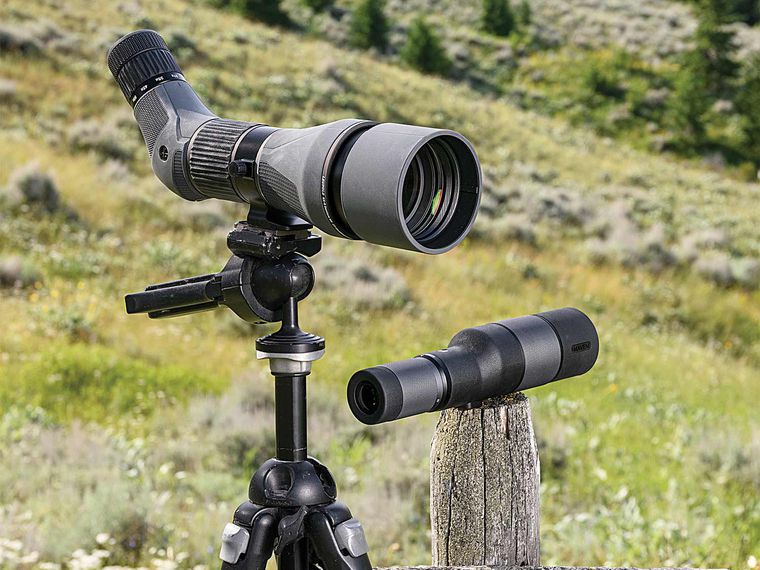
There is nothing that can replace the extreme close-up view of a spotting scope when climbing or watching wildlife. For example, when bird watching, binoculars get you close, but a spotting scope gets you those minute details for identification.
Spotting scopes are incredibly powerful and offer excellent image magnification. You can get a clear view of objects at a distance. In simple terms, spotting scopes can be termed as portable telescopes. So, how do you choose the best spotting scope for climbing and wildlife watching? For first time buyers, you want to take the guesswork out and find a perfect scope.
Most people that develop an interest in wildlife end up buying a binocular. However, for some keen observation and scanning, a spotting scope provides the best view. Whether studying shorebirds on a lakeside, scanning a waterfowl from far, or checking a hawk from a distance, a spotting scope is the best choice. This is the case when trying to find routes on your hiking trail. A quality spotting spot will help identify routes with ease.
Factors to Consider When Choosing a Spotting Scope for Climbing and Wildlife Watching
The following are some of the desired features to consider in a spotting scope for climbing and wildlife watching.
Magnification Numbers
A spotting scope delivers the largest magnification that the most powerful binoculars. It usually looks like a small telescope at first glance but that is not the case. Spotting scopes are more like a monocular because of their image-erecting prism system. Most spotting scopes produce high magnifications of 60X or higher. However, a larger magnification requires a bigger objective lens diameter.
For example, a magnification of 60X will usually have an objective lens diameter of 80mm. For climbing viewing and wildlife watching, spotting scopes with 60×80 magnification are perfect.
Supports
The excellent magnification of spotting scopes means having good support for the unit. This is a big consideration especially watching from a stationary position. You need to consider spotting scopes that easily attach to standard tripod stands. The good news is that tripod stands for spotting scopes are affordable. They don’t have to be strong and solid as stands for photography. All that birders need is something firm enough to withstand strong winds. However, make sure the stand extends enough to provide the perfect viewing height.
Straight versus Angled
Good scope models come in two configurations of angled and straight. The different configurations come with their pros and cons. The difference between the two configurations is the rear of the scope where the erecting prism directs lights. This can be in a straight line for the straight configuration and an angled line for the angled configuration.
For birders, deciding between a straight and angled scope is quite important. For beginners, straight scopes are a lot easier to use. However, angled spotting scopes are more comfortable when viewing. For a straight spotting scope, it is more intuitive finding the bird. If you’re birding as a group, then consider using an angled one. This is because it is a lot easier to use the same scope for persons of different heights. You also don’t need to raise angled spotting scopes so high reducing the shaking effects of wind.
However, if you’re birding alone, then a straight spotting scope is perfect. You just need a sturdy tripod stand to set the scope at your comfortable viewing height.
Glass Quality
The quality of glass used in the construction of the spotting scope is another important consideration. You need to choose scopes with modern lens coating to greatly improve the light transmission. Getting more light gives you brighter images. Ordinary glass blocks some light passing through reducing the image quality.
Check the glass specifications from the manufacturer before buying one. High-quality spotting scopes use the coated lens and multi-coated lenses. Poor quality glasses will cause chromatic aberrations which is the fringing of colors around the image. However, the good quality glass will add to the cost of glass so be sure to budget more.
Focusing and Close-focusing
Spotting scopes for wildlife watching and climbing offer two ways to focus on your image. The first way is a two-step focusing where the knob shifts from infinity to close-up. We also have a second one which offers close focusing through small adjustments. You get to fine-tune the spotting scope to the finest images.
Each of these mechanisms can work perfectly for watching wildlife. You just need to select one that feels comfortable on your hands.
Cases and Lens Caps
Since you’re out in the wild, you need the spotting scope properly stored when not in use. Consider spotting scopes that come with cases for safe storage. Some cover designs allow for the scope use while they are in place. Almost all spotting scopes have lens caps which help protect the lens from scratches.